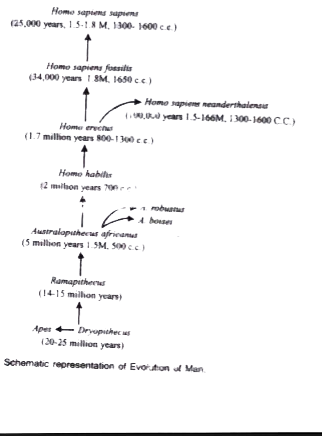Explain Human Evolution.
Text Solution
The ancestors of the man, the apes, left "thelrees and developed the requirements of ground life such as erect posture, longer hindlimbs, bipedal locomotion, freedom of fofelimbs for other purposes, perfection of binocular vision and lack of tail. The cerebral cortex of the brain became large making man the most intelligent creature.
The fossil evidence clearly indicates that the origin of man occurred in Central Asia. It has been established that Dryopithecus is one of the oldest fossil regarded a common, ancestor of man and great apes, some 25 million years ago. They were hairy, had arms and legs of the same length, more ape-like, with semi-erect position.
From Dryopithecus evolved prehistoric man Ramapithecus. He was more man like. It walked erect on hind feet. It also lived on the tree as well. Its jaws and teeth were like those of humans. Ramapithecus ate hard nuts and seeds. It became extinct about 7-8 million years back. Later in the evolution evolved Australopithecus (First ape-man). Australopithecus was about 4 feet high, had human as well as ape characters. He lived in East African grasslands 3.4 mya. He hunted with stone weapons but essentially ate fruit. It was with bipedal locomotion, walked upright and had erect posture. His brain capacity was 500 cc. He lived in caves.
He was the first human-like bering the hominid. The brain capacities were between 650-800 cc.
Homo habilis (Able or skilful man, the toolmaker).He lived in Africa about 2 million years ago. He was 1.2-1.5 m tall, with bipedal locomotion, erect posture and carnivorous, hunted large animals. He was capable of making tools. He also led community life in caves and greatly cared for the young ones.
Homo erectus (Erect man). Fossils discovered in Java, lived 1.5 mya. He was 1.5 - 1.8 m tall males were probably longer than females, had erect posture protruding jaws, projecting brow ridges. The cranial capacity was around 900 cc to accommodate large brain. Lips thick and protruding. He was omnivorous and cannibal. Perhaps he was the first prehistoric man to make use of fire for hunting, defence and cooking.

(i) Neanderthal man. He walked upright, had low brows, receding jaws and much stockier. Cranial capacity was 1400 cc, existed 40000 years ago, most numerous about 1 lac years ago, near east and central asia. They were legendary cave dwellers, adapted to cold environment. They were true predators, skill hunters. They used hides to protect themselves from harsh climate and buried their dead. It is usually considered that the y did not evolved into Homo sapiens.
(ii) Cro-magnon man (Homosapiens fossils) : They emerged about 34000 years ago. They arose in Africa and moved across continents and developed into distinct races. Cro-magnon man was 1.8m tall, with well built body, elevated nose, broad and arched forehead, moderate brow ridges.
Cranial capacity 1650 cc, more intelligent and cultured than the man of today lived in families in caves, made excellent tools and ornaments from stones, bones and elephant tusks. A number of paintings done by cro-magnon man have been discovered. Spears, bows and arrows were his tools. He became extinct 10000-11000 years ago. He was the direct ancestor of the living modern man.
(iii) The living modern man (Homo sapiens sapiens) : He arose during ice age between 75000-10000 years ago. Evolution after Cromagnonman involves the evolution of culture, rather than that of anatomy. He started spreading all over the world about 100 years ago. Prehistoric cave art developed about 18000 years ago. Agriculture came around 10000 years back. He first appeared around Caspean and Mediterranean sea and then migrated west, south, east, changing into the present day white or caucasoids, mongoloid and black or negroid races.
|
Updated on:21/07/2023
Related Playlists
- BOOK - BETTER CHOICE PUBLICATIONCHAPTER - EVOLUTION EXERCISE - LONG ANSWER TYPE QUESTIONS (5 Marks)19videos
EVOLUTION
- BOOK - BETTER CHOICE PUBLICATIONCHAPTER - ENVIRONMENTAL ISSUES EXERCISE - LONG ANSWER43videos
ENVIRONMENTAL ISSUES
- BOOK - BETTER CHOICE PUBLICATIONCHAPTER - HUMAN HEALTH AND DISEASEEXERCISE - LONG ANSWER TYPE QUESTIONS (MOST EXPECTED QUESTIONS)12videos
HUMAN HEALTH AND DISEASE
Similar Questions
Identify the stages in human evolution.
The toolmaker __________View SolutionArtificial Selection and Human Evolution
View SolutionDiscussion class 5 (Human Evolution)
View SolutionWhich is correct regarding human evolution ?
View SolutionExplain the evolution of man.
View SolutionExplain the evolution of giraffe's neck according to Lamarck's theory of evolution.
View SolutionExplain the evolution of giraffe's neck according to Lamarck's theory of evolution.
View SolutionHuman Evolution|Similarities Between Apes And Man|Differences Between Apes And Man|Characters Of Human Evolution|Fossil Study |Trick
View SolutionDepict human evolution with the help of a figure
View SolutionTrends in humane evolution have been
View Solution

